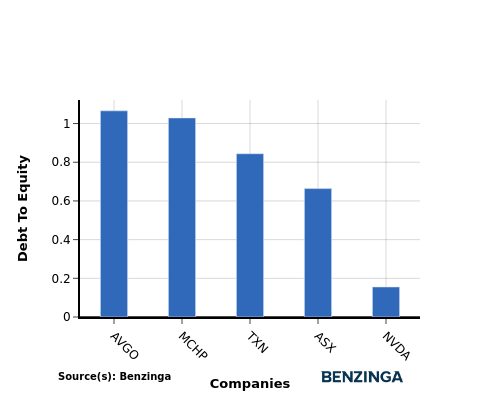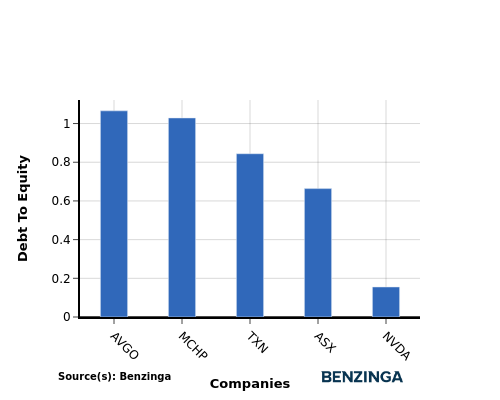In today's fast-paced and highly competitive business world, it is crucial for investors and industry followers to conduct comprehensive company evaluations. In this article, we will delve into an extensive industry comparison, evaluating NVIDIA NVDA in relation to its major competitors in the Semiconductors & Semiconductor Equipment industry. By closely examining key financial metrics, market standing, and growth prospects, our objective is to provide valuable insights and highlight company's performance in the industry.
NVIDIA Background
Nvidia is a leading developer of graphics processing units. Traditionally, GPUs were used to enhance the experience on computing platforms, most notably in gaming applications on PCs. GPU use cases have since emerged as important semiconductors used in artificial intelligence. Nvidia not only offers AI GPUs, but also a software platform, Cuda, used for AI model development and training. Nvidia is also expanding its data center networking solutions, helping to tie GPUs together to handle complex workloads.
| Company | P/E | P/B | P/S | ROE | EBITDA (in billions) | Gross Profit (in billions) | Revenue Growth |
|---|---|---|---|---|---|---|---|
| NVIDIA Corp | 54.05 | 50.88 | 30.05 | 31.13% | $22.86 | $26.16 | 93.61% |
| Taiwan Semiconductor Manufacturing Co Ltd | 29.39 | 7.74 | 11.65 | 8.36% | $555.05 | $439.35 | 38.95% |
| Broadcom Inc | 133.07 | 11.72 | 16.31 | -2.77% | $6.39 | $8.36 | 47.27% |
| Advanced Micro Devices Inc | 121.88 | 3.92 | 9.27 | 1.36% | $1.55 | $3.42 | 17.57% |
| Texas Instruments Inc | 37.35 | 10.62 | 11.74 | 7.86% | $2.09 | $2.47 | -8.41% |
| Qualcomm Inc | 17.55 | 6.64 | 4.55 | 11.46% | $3.21 | $5.78 | 18.69% |
| ARM Holdings PLC | 226.03 | 23.90 | 41.09 | 1.83% | $0.11 | $0.81 | 4.71% |
| Micron Technology Inc | 145.43 | 2.51 | 4.53 | 1.99% | $3.63 | $2.74 | 93.27% |
| Analog Devices Inc | 66.78 | 3.09 | 11.59 | 1.36% | $1.12 | $1.42 | -10.06% |
| Microchip Technology Inc | 47.51 | 5.85 | 6.77 | 1.24% | $0.34 | $0.67 | -48.37% |
| ON Semiconductor Corp | 17.57 | 3.51 | 4.18 | 4.75% | $0.63 | $0.8 | -19.21% |
| Monolithic Power Systems Inc | 64.50 | 11.87 | 13.73 | 6.35% | $0.17 | $0.34 | 30.59% |
| STMicroelectronics NV | 10.52 | 1.31 | 1.69 | 1.98% | $0.74 | $1.23 | -26.63% |
| ASE Technology Holding Co Ltd | 19.37 | 2.22 | 1.17 | 3.16% | $28.59 | $26.43 | 3.85% |
| First Solar Inc | 16.57 | 2.71 | 5.37 | 4.22% | $0.45 | $0.45 | 10.81% |
| United Microelectronics Corp | 10.80 | 1.51 | 2.42 | 4.0% | $29.73 | $20.43 | 5.99% |
| Skyworks Solutions Inc | 23.38 | 2.18 | 3.34 | 0.95% | $0.18 | $0.43 | -15.9% |
| MACOM Technology Solutions Holdings Inc | 129.46 | 8.65 | 13.58 | 2.67% | $0.05 | $0.11 | 33.47% |
| Lattice Semiconductor Corp | 54.88 | 10.98 | 13.79 | 1.03% | $0.03 | $0.09 | -33.87% |
| Universal Display Corp | 32.49 | 4.84 | 11.98 | 4.29% | $0.08 | $0.13 | 14.57% |
| Average | 63.4 | 6.62 | 9.93 | 3.48% | $33.38 | $27.13 | 8.28% |
When conducting a detailed analysis of NVIDIA, the following trends become clear:
-
With a Price to Earnings ratio of 54.05, which is 0.85x less than the industry average, the stock shows potential for growth at a reasonable price, making it an interesting consideration for market participants.
-
The elevated Price to Book ratio of 50.88 relative to the industry average by 7.69x suggests company might be overvalued based on its book value.
-
With a relatively high Price to Sales ratio of 30.05, which is 3.03x the industry average, the stock might be considered overvalued based on sales performance.
-
The company has a higher Return on Equity (ROE) of 31.13%, which is 27.65% above the industry average. This suggests efficient use of equity to generate profits and demonstrates profitability and growth potential.
-
With lower Earnings Before Interest, Taxes, Depreciation, and Amortization (EBITDA) of $22.86 Billion, which is 0.68x below the industry average, the company may face lower profitability or financial challenges.
-
The company has lower gross profit of $26.16 Billion, which indicates 0.96x below the industry average. This potentially indicates lower revenue after accounting for production costs.
-
The company is experiencing remarkable revenue growth, with a rate of 93.61%, outperforming the industry average of 8.28%.
Debt To Equity Ratio

The debt-to-equity (D/E) ratio helps evaluate the capital structure and financial leverage of a company.
Considering the debt-to-equity ratio in industry comparisons allows for a concise evaluation of a company's financial health and risk profile, aiding in informed decision-making.
When comparing NVIDIA with its top 4 peers based on the Debt-to-Equity ratio, the following insights can be observed:
-
Compared to its top 4 peers, NVIDIA has a stronger financial position indicated by its lower debt-to-equity ratio of 0.16.
-
This suggests that the company relies less on debt financing and has a more favorable balance between debt and equity, which can be seen as a positive attribute by investors.
Key Takeaways
The low P/E ratio suggests that NVIDIA may be undervalued compared to its peers in the Semiconductors & Semiconductor Equipment industry. However, the high P/B and P/S ratios indicate that the stock may be overvalued based on its book value and sales. On the other hand, the high ROE, low EBITDA, low gross profit, and high revenue growth suggest that NVIDIA is performing well in terms of profitability and growth compared to its industry peers.
This article was generated by Benzinga's automated content engine and reviewed by an editor.
© 2024 Benzinga.com. Benzinga does not provide investment advice. All rights reserved.








